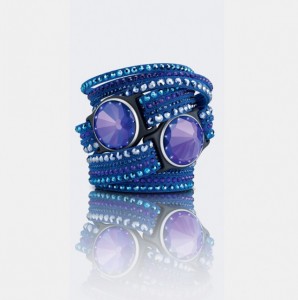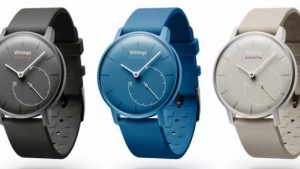 Are you Feelin’ Groovy about wearables? Well slow down, you move too fast…
Are you Feelin’ Groovy about wearables? Well slow down, you move too fast…
…at least, according to Accenture’s latest survey into consumers’ perspectives on new technologies, published this week in conjunction with the 2015 Consumer Electronics Show in Las Vegas, the largest annual convention in the U.S. featuring technology for people.
 At #CES2015, we’re seeing a rich trove of blinged-out, multi-sensor, shiny new wearable things at the 2015 Consumer Electronics Show. Swarovski crystals are paired with Misfit Wearables, called the Swarovski Shine, shown here as a shiny new thing, indeed. Withings launched its Activite fitness tracking watch in new colors. There’s an abundance of new-and-improved health wearables from brands we’ve known, and new entrants exhibiting this year, as well, to add to the Battle for the (Wrist)Bands and other parts of the human body.
At #CES2015, we’re seeing a rich trove of blinged-out, multi-sensor, shiny new wearable things at the 2015 Consumer Electronics Show. Swarovski crystals are paired with Misfit Wearables, called the Swarovski Shine, shown here as a shiny new thing, indeed. Withings launched its Activite fitness tracking watch in new colors. There’s an abundance of new-and-improved health wearables from brands we’ve known, and new entrants exhibiting this year, as well, to add to the Battle for the (Wrist)Bands and other parts of the human body.
 That’s the supply side. But to us economists, and especially the health economists among us (like me), examining the demand side — that is, users, consumers, patients, caregivers, and mainstream well-folk – gives us a snapshot of some of the challenges people face when opening up the pretty package containing that health-focused wearable device.
That’s the supply side. But to us economists, and especially the health economists among us (like me), examining the demand side — that is, users, consumers, patients, caregivers, and mainstream well-folk – gives us a snapshot of some of the challenges people face when opening up the pretty package containing that health-focused wearable device.  Accenture found that:
Accenture found that:
- 83% of consumers who bought an intelligent device had difficult using it out of the box
- Among wearable health-tech purchasers, 22% said the device didn’t set up properly
- 24% of health-wearable consumers said the device was too complicated to use
- 21% said the tech’s didn’t work as advertised.
About 8% of people own a wearable fitness device, according to the Accenture study. In terms of intent-to-purchase in the future, 12% plan to buy a wearable health-tech within 12 months; 17% within 1-3 years, and another 11% in 3-5 years. This nets to 40% of people intending to purchase within 5 years of the 2015 Consumer Electronics Show.
Accenture summarized the survey findings in this infographic.
Health Populi’s Hot Points: Reliability, affordability, and usability are three legs of a well-balanced wearables stool when it comes to building a healthy wearables market, according to Nate Williams of Greenwave Systems. Greenwave is involved in the growing Internet of Things space, and Nate and I spent time in a one-on-one conversation yesterday brainstorming IoT, wearables, and health.
Accenture’s data points to the reliability and usability aspects of Nate’s equation: he and other organizational partners who are members of the Internet of Things Consortium conducted a consumer survey prior to the #CES2015, and found that word-of-mouth is the strongest marketing asset for companies developing consumer-facing technologies under the IoT umbrella. This goes for wearables, as well, which in my evolving thinking about IoT converging with health, fits nicely into the connected-health paradigm.
As for affordability, research from PwC recently found that health consumers are keen to spend as little of their own out-of-pocket money as possible on a health wearable, in favor of an employer or health plan subsidizing, or giving, them a device. Even better, the third party could provide an incentive for the consumer to use the device, to promote stickiness and ongoing monitoring of health metrics that could bolster behavior change beyond the typical three-to-six month use and abandonment of the technology. Note that Oscar, the new-new health plan, is partnering with Misfit Wearables, to channel the device to plan members. And employers have been an important marketing channel for a few of the more successful health wearables companies.
 Does Accenture’s survey paint a Hazy Shade of Winter when it comes to the market on the demand side of health-focused wearable devices for #CES2015? We must summon the user-centered designers, like Amy Cueva of Mad*Pow and the inspired folks at IDEO, along with ethnographers and anthropologists who work at places like Intel where they observe people where we live, work, and play. That’s where health happens, and that’s where design inspiration for usability must be borne.
Does Accenture’s survey paint a Hazy Shade of Winter when it comes to the market on the demand side of health-focused wearable devices for #CES2015? We must summon the user-centered designers, like Amy Cueva of Mad*Pow and the inspired folks at IDEO, along with ethnographers and anthropologists who work at places like Intel where they observe people where we live, work, and play. That’s where health happens, and that’s where design inspiration for usability must be borne.




 Interviewed live on BNN Bloomberg (Canada) on the market for GLP-1 drugs for weight loss and their impact on both the health care system and consumer goods and services -- notably, food, nutrition, retail health, gyms, and other sectors.
Interviewed live on BNN Bloomberg (Canada) on the market for GLP-1 drugs for weight loss and their impact on both the health care system and consumer goods and services -- notably, food, nutrition, retail health, gyms, and other sectors. Thank you, Feedspot, for
Thank you, Feedspot, for  As you may know, I have been splitting work- and living-time between the U.S. and the E.U., most recently living in and working from Brussels. In the month of September 2024, I'll be splitting time between London and other parts of the U.K., and Italy where I'll be working with clients on consumer health, self-care and home care focused on food-as-medicine, digital health, business and scenario planning for the future...
As you may know, I have been splitting work- and living-time between the U.S. and the E.U., most recently living in and working from Brussels. In the month of September 2024, I'll be splitting time between London and other parts of the U.K., and Italy where I'll be working with clients on consumer health, self-care and home care focused on food-as-medicine, digital health, business and scenario planning for the future...